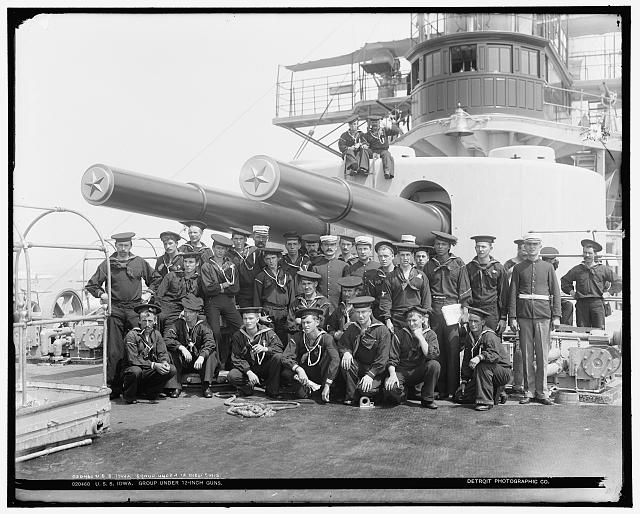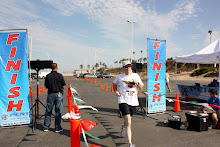USS Iowa (BB-4)
"Queen of the Navy"
"Queen of the Navy"
The BB-61 will not be the first battleship named Iowa to anchor at San Pedro.
March 11-12, 1900: the Los Angeles Times reported 4,000 people visited an earlier battleship with the same name, the BB-4 (commissioned on June 16, 1897) -- at San Pedro Harbor. This ship sailed from San Diego and was on her way to Santa Barbara when she visited Los Angeles Harbor for a couple of days, coated in dust from the coaling she had received down south. Three tugs from the Banning Company, the Warrior, Collis, and Falcon, helped ferry visitors for 50 cents each to the famous battleship.
Late October 1900, the BB-4 returned and, along with the cruiser Philadelphia (C-4), lay about a mile off San Pedro. (The Philadelphia had served as the flagship of the Pacific Station until February 1900, when it transferred its flag to the Iowa.) Two tugboats from San Pedro and smaller launches from Terminal helped ferry visitors to the Iowa. As reported at the time, the whole of the ship, from "conning tower to stoke hole was thrown open to the visitors." The conning tower was made with walls that were two feet thick.
March 11-12, 1900: the Los Angeles Times reported 4,000 people visited an earlier battleship with the same name, the BB-4 (commissioned on June 16, 1897) -- at San Pedro Harbor. This ship sailed from San Diego and was on her way to Santa Barbara when she visited Los Angeles Harbor for a couple of days, coated in dust from the coaling she had received down south. Three tugs from the Banning Company, the Warrior, Collis, and Falcon, helped ferry visitors for 50 cents each to the famous battleship.
 |
| USS Iowa (BB-4) at anchor early 1900s. U.S. Naval Historical Center photo |
Before her arrival at San Pedro and the West Coast, the BB-4 had played an important role in the Spanish-American War in the Battle of Santiago (July 1898), helping to smash Spain's naval forces in the Western Hemisphere. The BB-4 served along the West Coast until 1902.
 |
| Group under 12-inch guns on the BB-4, 1898; Library of Congress photo |
The USS Iowa (BB-4) was largely tied up during World War I, and afterwards the aging battleship was used for experimentation concerning "the control of ships by wireless." In December 1922, the Iowa's death sentence was read aboard Admiral E.W. Eberle's flagship California in Los Angeles Harbor. The Iowa, once referred to as the "Queen of the Navy," was to be used as long-range target practice.
***
***
***
USS Iowa (BB-61)
"The Big Stick"
"The Big Stick"
San Pedro's soon-to-be waterfront attraction, the BB-61, was commissioned on February 22, 1943, and was decommissioned nearly a half century later. Between these years, she was was no stranger to the Los Angeles and Long Beach harbor areas. Here is the history of the Big Stick's local visits, including the story of her famous AWOL canine mascot named Victory.
November 1, 1945: The Iowa led two groups of warships into L.A. Harbor. The cruiser Atlanta accompanied the Big Stick, along with the destroyers Barton, Hale, Nicholas, Walke, and Walker. The other group consisted of the light cruisers Amsterdam and Topeka, along with the destroyers Allen Sumner, Franks, Heermann, Moale, Taylor and Woodworth. The ships Marine Tiger and Thetis Bay also entered the harbor, and together carried about 4,500 troops of the Avengers of Bataan 38th Infantry Division. A day earlier, the battleships Wisconsin (Iowa's sister ship), Alabama and South Dakota, light cruiser Vicksburg and the destroyer Buchanan had also dropped anchor at Los Angeles Harbor. On November 9, the Iowa left San Pedro to visit Santa Barbara briefly so residents there could view the mighty battleship.
November 29, 1945: USS Iowa's "Dog Mascot Goes A.W.O.L. Again"
Search parties looked all over the Long Beach environs for the small brown and white canine named "Victory" or "Vicky/Vickie" for short, with no initial luck. The Times reported that Vicky had been with the Iowa since its commissioning, had substituted for President Roosevelt's dog Fala when the the commander-in-chief went to the Tehran conference aboard the ship in 1943, and "was the first American dog in Japan" after the Japanese surrender. Vicky, who was said to have a "number of decorations on his white collar," had gone "absent without leave" before (in San Francisco & on an island in the Carolines), but had always returned before the Iowa left port.
The Iowa crew's calls for help from Long Beach and Los Angeles residents apparently worked. A report a couple of weeks later states that Vicky was aboard the ship in Long Beach Harbor playing with Times newspaper carriers who were visiting. It was also noted that Vicky's "201,778-mile voyage aboard the Iowa has earned him the reputation of the most-traveled dog in the Navy."
December 3, 1945: Fifteen hundred Southern California transplants, former residents of the state of Iowa, visited the Big Stick which was at anchor off Los Angeles-Long Beach Harbors. Captain Frederick I. Entwistle, commanding officer of the ship, presented the Iowans with a "ship's pennant, the ship's banner and the American Flag flown by the Iowa in its raid off the shores of Japan." The Long Beach Iowa Society gladly accepted these historic gifts. Long Beach Mayor Herbert E Lewis proclaimed at the time that "Long Beach is as proud of the Iowans as the Iowans are of the U.S.S. Iowa."
December 16, 1945: The Times also reported that the USS Iowa, "the biggest battleship in the world," went into the "biggest drydock on the North American continent," -- the 1100-foot long Morreel Drydock on nearby Terminal Island. This was the first drydocking the Iowa had received since the war ended.
This drydock was described as an enormous bathtub able to accommodate any ship afloat. While Morreel handled the 887-feet long, 45,000-ton battleship with ease, due to the ship's weight, the drydock pumps emptied the "bathtub" in less than an hour. This operation usually took up to two and one-half hours.
Captain George T. Paine, commander of the Terminal Island Naval Shipyard, boasted how this showed that the area had the facilities to care for "any and all needs of the Fleet." It was also reported that more than 70 naval vessels were then undergoing repair or conversion at the Los Angeles and Long Beach harbors.
April 7, 1946: The USS Iowa, flagship of the U.S. 5th Fleet under the command of Vice Admiral Frederick C. Sherman, dropped anchor in Los Angeles-Long Beach Harbor after a 13-day sail from Japan. According to the Dictionary of American Naval Fighting Ships, from about this time through September 1948, the Iowa "operated from West Coast ports, on Naval Reserve and at sea training and drills and maneuvers with the Fleet."
August 7, 1948: 850 midshipmen from colleges around the country steamed into Los Angeles Harbor aboard the Iowa, where they transferred to four destroyers inside the breakwater and went to San Diego. The Iowa, along with other warships, had just completed an eight-week cruise near Hawaii.
August 12, 1950: 50,000 Iowans gathered at Recreational Park in Long Beach for the 45th annual Iowa picnic. Although this event did not occur on the battleship, W. Ward Johnson of the Iowa Association of Long Beach presented an important gift to the state of Iowa: the flag that had flown on the mast of the Iowa through World War II and was given to the association in 1945 (see the Dec. 3, 1945 entry above). Governor Earl Warren also made ominous remarks at the festivities, warning that the Korean War could reach American shores and that a single atomic bomb dropped on a large city could lead to 400,000 casualties and 200,000 deaths.
November 3, 1951: The Times reported that the Iowa dropped anchor in the Long Beach-Los Angeles Outer Harbor, which was then to become her home port. Captain William R. Smedberg III was in command and after a two-hour inspection, granted many sailors of the ship liberty. The Iowa stayed near Long Beach until November 19, when she went to Hawaii for a month-long training cruise and then planned to return to the area.
The Dictionary of American Naval Fighting Ships notes that "after Communist aggression in Korea necessitated an expansion of the active fleet" the Iowa was recommissioned in August 1951, and "operated off the West Coast until March 1952, when she sailed for the Far East."
December 1951: As part of Navy repair contracts awarded to local shipyards, the Long Beach Marine Repair Yard was awarded a small contract for work on the Iowa. The reported amount for the work was $815.
 |
| USS Iowa in 1952, U.S. Navy Photograph |
January 16-17 1952: The crew of the Iowa donated 1020 pints of blood to the Long Beach Chapter of the Red Cross.
January 20, 1952: About 12,000 people, including employees, descended upon the Long Beach Naval Shipyard, to tour the Iowa for an open house, and also visited the escort carrier U.S.S. Sicily, and other fighting ships. They also watched "Herman the German" lift and move a 270-ton railroad crane from one pier to another. Herman the German was an enormous floating crane seized from Germany at the end of World War II. A model of this crane can be seen at the Los Angeles Maritime Museum in San Pedro.
 |
| YD-171, more commonly known as "Herman the German" at the LBNS Port of Long Beach image |
February 1, 1952: Dense fog caused a series of mishaps in the Los Angeles area, including one involving the Iowa. As reported at the time, the Admiral, a 58-foot long boat "transporting 49 sailors to the USS Iowa in the Outer Harbor, struck the Long Beach breakwater at about 2:15 a.m." The seamen and two members of the Admiral crew climbed onto the rocks and had to yell off and on until 10:00 a.m. until a fishing vessel named the American Star heard their pleas and rescued them.
 |
| USS Iowa (BB-61) off Koje, Korea, firing her 16-inch guns at the enemy coast October 17, 1952 U.S. Naval Historical Center Photograph |
*If you know of any other historical visits of the USS Iowa to the Port of Los Angeles, please post!
Sources: Los Angeles Times, Dictionary of American Naval Fighting Ships, Naval Historical Center, Popular Mechanics


